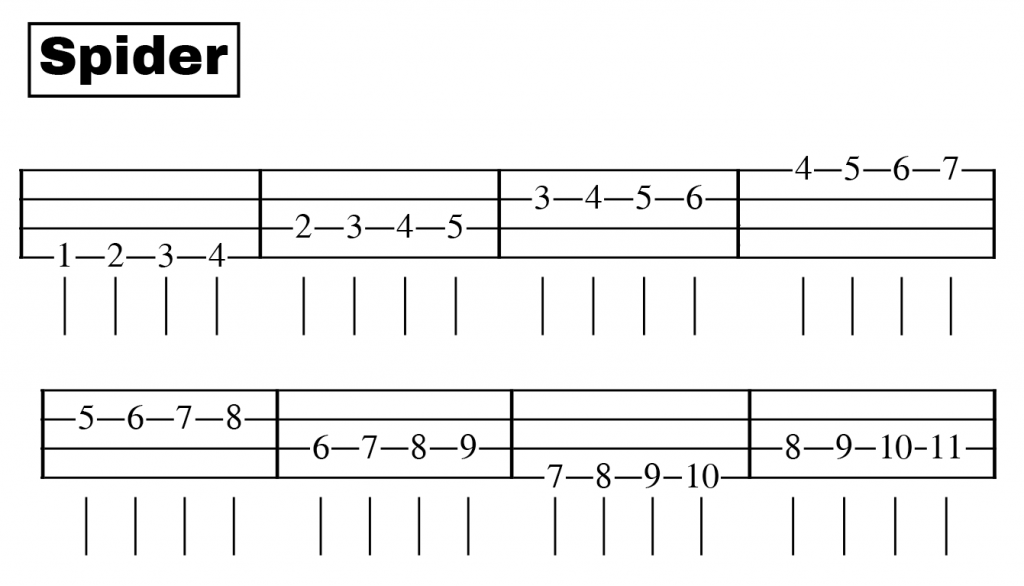Playing songs is one way to practice but it’s also important to focus purely on technique sometimes. So today we’re going to take a look at some exercises that will develop your fretting hand abilities.
All of the exercises below are intended to develop your finger dexterity, speed and finger strength. They’re a good way to warm your hands up before you start playing, or perhaps before you start to learn a specific song.
The 1234
We’ll start with the classic 1234. For this we start with our index finger on the first fret of the G string. We pick the note and then add our second finger to the second fret and pick again. This is repeated using our third finger on the third fret and pinkie finger on the fourth fret. Each finger takes a fret.

Once we’ve got to our pinkie finger we then drop down to the C string and start again at the first fret.
When we arrive at the A string, we then slide up and start with our index finger on the second fret. This means that your second finger gets the third fret, ring finger getting the fourth fret and pinkie on the fifth.
In this pattern we keep moving up one fret at a time. I would suggest you do this until your pinkie finger is landing at the twelfth fret.
The Spider
The spider is very similar to the 1234 with a small variation. As we change strings, we also move up a fret at the same time. This creates a kind of zig-zag pattern across the fretboard and will get you used to not only switching strings, but also switching frets.
Have a look at the tab below and it should start to make sense.

The Reverse 1234 (The 4321)
The Reverse 1234, or The 4321 takes the same structure as the 1234 but flips it on it’s head. Instead of starting at the first fret and using our index finger, we’re actually starting on the fourth fret and using our pinkie finger.
Once we’ve played this note, we drop a fret and play the third fret with our third finger.
When we get down to our index finger we jump down a string just like we did with the 1234.
Here’s the tab.

The Reverse Spider
Much like our reversed 1234, the reversed spider (or should that be The Redips?) again starts with our pinkie at fret 4. The pattern is essentially the same as the spider but we’re moving down the notes rather than up them.

The Hammer Up
It’s time to bring the hammer ons into play. The hammer up takes the same form as the 1234 but introduces a hammer on into proceedings.
Start with your index finger on the first fret of G string, pluck the note and hammer on using your second finger at fret 2.

After this we return to plucking the note from the first fret of the G string, this time hammering on with our third finger at the third fret.
We then do the same again but this time switching to hammering on at the 4th fret with our pinkie finger. Just like the 1234, once we’ve done all 4 frets we move down to the C string, then down to the E string, then A string. After this we simply slide up a fret and do it all over again.
The Pull Down
The Pull Down is essentially the opposite of the hammer up. Instead of hammering on, we’re using pull offs. Now you can do this in any order you like but I tend to start with my first and second fingers on the first 2 frets (again we’re staring on the G string here). Pluck the note which is fretted at the second fret, then pull off to sound the note from the first fret.

We then continue this with our other fingers so we’re pulling off from the third to the first fret, and the fourth to the first fret. Hopefully you’ve got the idea, all of these following the same pattern.
And that’s it.
You can grab a PDF of the tab for these exercises below…
Final Thoughts
I wouldn’t suggest you do huge amounts of time with these exercises, even just a couple of minutes on each practice session would go a long way. They can get a little tedious if you commit too much time to them in one session but a little and often will really work wonders for you.



